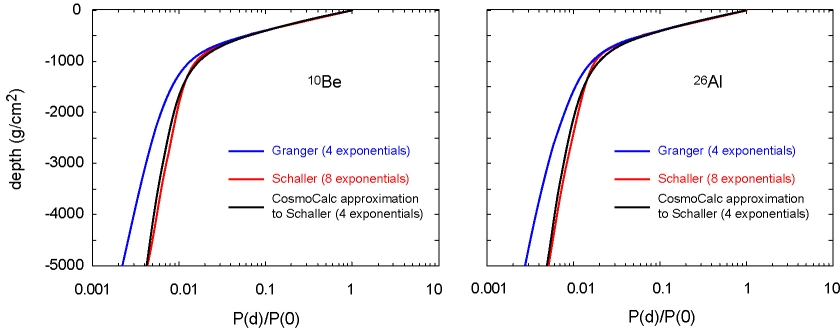The interface of CosmoCalc is very simple because default values are set for most of the parameters that occur in the various equations discussed in this paper (Table 1). This greatly reduces the chance that novice users make mistakes when reducing their TCN data. For more advanced users, the program allows nearly all the parameters to be changed.
Specifying the production rate calibration sites
As mentioned in Section 2, it is very important to use
a consistent set of scaling factors for the unknown sample and the
production rate calibration site. Failing to do so can cause
significant systematic errors. To avoid this, CosmoCalc defines the
SLHL production rates implicitly, by specifying a set of
calibration sites and their measured TCN concentrations. Using the
``Calibration sites'' form of the ``Settings'' menu, these
concentrations are scaled to SLHL and an average production rate is
calculated using one of the five scaling models of Section
2. CosmoCalc comes with a default set of published
production rate calibrations, some of which (![]() Be and
Be and ![]() Al)
were borrowed from Balco and Stone (2007;
http://hess.ess.washington.edu/math). The published data
come from a variety of latitudes and elevations, yielding a presumably
reliable estimate of the globally averaged production rates. This,
however, is not always the best approach. For example, if a TCN study
is carried out in the vicinity of one particular calibration site,
then it makes more sense to use only this site to estimate the local
production rate. Therefore, CosmoCalc offers the user the flexibility
to delete or add calibration sites at will.
Al)
were borrowed from Balco and Stone (2007;
http://hess.ess.washington.edu/math). The published data
come from a variety of latitudes and elevations, yielding a presumably
reliable estimate of the globally averaged production rates. This,
however, is not always the best approach. For example, if a TCN study
is carried out in the vicinity of one particular calibration site,
then it makes more sense to use only this site to estimate the local
production rate. Therefore, CosmoCalc offers the user the flexibility
to delete or add calibration sites at will.
Changing the relative contributions of different production pathways
Being based on the equation of Granger and Smith (2000), the TCN
production equation consists of four exponentials: one for neutrons,
two for slow neutrons, and one for fast neutrons (see Equation
8 and Section 5). These exponentials are
governed by two sets of parameters: the fractions ![]() and the
attenuation lengths
and the
attenuation lengths ![]() (for i=0,...,3). Default values for
(for i=0,...,3). Default values for
![]() ,
, ![]() (
(![]() Be) and
Be) and ![]() (
(![]() Al) were taken from
Granger and Smith (2000) (Table 1), but these values
can be changed in the ``Settings'' form.
Al) were taken from
Granger and Smith (2000) (Table 1), but these values
can be changed in the ``Settings'' form.
In addition to Equation 8, several alternative, but similar looking TCN ingrowth equations exist in the literature. Schaller et al. (2001, 2002) use not four but eight exponentials (two for neutrons, and three for each slow and fast muons), whereas others use three (one for each production mechanism) (e.g., Braucher et al., 2003; Miller et al., 2006) or only one exponential (neglecting muon production). CosmoCalc provides a separate set of default parameters for each of these alternatives. For example, the ingrowth equation of Schaller et al. (2002) was recast in the parameterization of Granger and Smith (2000) by a least squares fit of a virtual depth profile (Figure 4).

|